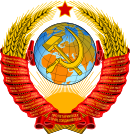| This article needs additional citations for verification. Please help improve this article by adding citations to reliable sources. Unsourced material may be challenged and removed. Find sources: "Soviet cuisine" – news · newspapers · books · scholar · JSTOR (December 2009) (Learn how and when to remove this message) |
You can help expand this article with text translated from the corresponding article in Russian. (August 2023) Click for important translation instructions.
|
| Part of a series on the |
| Culture of the Soviet Union |
|---|
 |
| History |
| People |
| Languages |
| Traditions |
| Cuisine |
| Festivals |
| Religion |
| Art |
| Literature |
| Music |
| Media |
| Sport |
| Monuments |
Symbols
|
Soviet cuisine, the common cuisine of the Soviet Union, was formed by the integration of the various national cuisines of the Soviet Union, in the course of the formation of the Soviet people. It is characterized by a limited number of ingredients and simplified cooking. This type of cuisine was prevalent in canteens everywhere in the Soviet Union. It became an integral part of household cuisine and was used in parallel with national dishes, particularly in large cities. Generally, Soviet cuisine was shaped by Soviet eating habits and a very limited availability of ingredients in most parts of the USSR. Most dishes were simplifications of French, Russian, Austro-Hungarian cuisines, and cuisines from other Eastern Bloc nations. Caucasian cuisines, particularly Georgian cuisine, contributed as well.
To a significant extent it was reflected in and formed by The Book of Tasty and Healthy Food, first printed in 1939, following the directions of Anastas Mikoyan.
See also
- Armenian cuisine
- Ashkenazi Jewish cuisine
- Azerbaijani cuisine
- Bashkir cuisine
- Belarusian cuisine
- Buryat cuisine
- Chechen cuisine
- Chukchi cuisine
- Cossack cuisine
- Georgian cuisine
- Kazakh cuisine
- Komi cuisine
- Kyrgyz cuisine
- Moldovan cuisine
- Mordovian cuisine
- Ossetian cuisine
- Russian cuisine
- Sakha cuisine
- Tajik cuisine
- Tatar cuisine
- Turkmen cuisine
- Ukrainian cuisine
- Uzbek cuisine
References
- Scott, Erik R. (2012). "Edible Ethnicity How Georgian Cuisine Conquered the Soviet Table". Kritika: Explorations in Russian and Eurasian History. 13 (4): 831–858. doi:10.1353/kri.2012.0051. S2CID 159764807. Project MUSE 488176.
- Russell, Polly (16 August 2013). "The history cook: The Book of Tasty and Healthy Food". Financial Times.
Further reading
- Wheeler, Sara (13 September 2013). "Beyond Borscht". The New York Times.
- Voronina, Tatiana (2016). "From Soviet Cuisine to Kremlin Diet: Changes in Consumption and Lifestyle in Twentieth-Century Russia". In Oddy, Derek J.; Atkins, Peter J.; Amilien, Virginie (eds.). The Rise of Obesity in Europe: A Twentieth Century Food History. Routledge. pp. 33–44. doi:10.4324/9781315553412. ISBN 978-1-317-01756-1.
- Pirogovskaya, Maria (August 2017). "Taste of Trust: Documenting Solidarity in Soviet Private Cookbooks, 1950–1980s". Journal of Modern European History. 15 (3): 330–349. doi:10.17104/1611-8944-2017-3-330. S2CID 148597819.
- Jacobs, Adrianne K. (2013). "V.V. Pokhlëbkin and the search for culinary roots in late soviet Russia". Cahiers du monde russe. 54 (1–2): 165–186. doi:10.4000/monderusse.7930.
- Gronow, Jukka; Zhuravlev, Jukka (2011). "The book of tasty and healthy food: The establishment of Soviet haute cuisine". In Strong, Jeremy (ed.). Educated Tastes: Food, Drink, and Connoisseur Culture. U of Nebraska Press. pp. 24–57. ISBN 978-0-8032-1935-9.
| Soviet Union topics | |||||||||||||
|---|---|---|---|---|---|---|---|---|---|---|---|---|---|
| History |
| ||||||||||||
| Geography |
| ||||||||||||
| Politics |
| ||||||||||||
| Economy | |||||||||||||
| Science | |||||||||||||
| Society |
| ||||||||||||